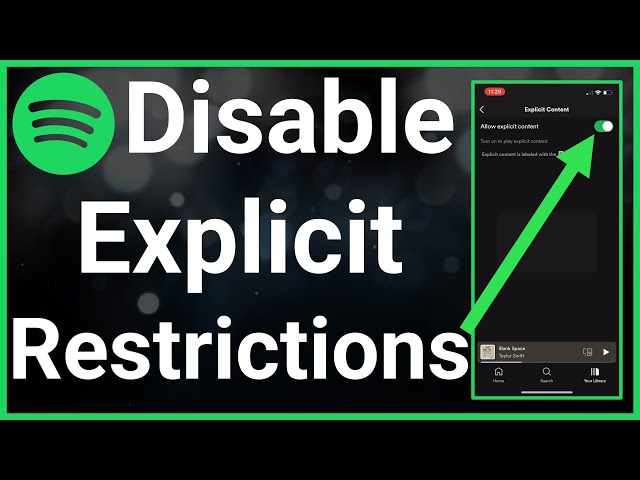Have you ever noticed a little “E” next to some songs on Spotify? This symbol indicates that the track contains explicit content. Spotify uses the “E” to warn listeners that the song has profanity, sexual references, violence, or other mature themes that may be offensive.
Understanding what the “E” means can help you avoid surprised or awkward moments when listening with kids or sensitive audiences. It also allows users to quickly identify songs with explicit lyrics if that’s the type of content they wish to find.
What Does the “E” Symbolize?
The “E” is short for “explicit.” Some other streaming platforms like Apple Music use “E” while others like YouTube Music use “EX” to indicate the same thing.
Songs marked with the explicit tag contain mature content such as:
- Strong language/profanity
- Violence/disturbing themes
- Sexual references
- Drug/alcohol references
The explicit tag serves as a warning to listeners about the nature of the lyrics. This allows users to avoid playing songs with swear words or adult topics around kids or in professional settings.
How Spotify Flags Explicit Content
Spotify does not manually assign the “E” symbol to tracks. Instead, the platform relies on metadata from music labels and content providers.
When a record label or artist distributes a song to streaming services like Spotify, they are responsible for attaching a parental advisory warning if the content is explicit. The parental advisory can come in the form of an “E” or “EX” tag.
Spotify automatically imports this metadata and displays the “E” next to explicit songs. However, mistakes occasionally happen where clean songs are mislabeled or explicit tracks don’t get flagged. Users can report errors to Spotify for review.
Who Decides What is Explicit?
Decisions about what content deserves the explicit tag are made by music labels and distributors, not the streaming service. Spotify does not have direct control over applying parental advisory warnings.
Labels have internal standards for reviewing lyrics and audio to determine if a song crosses the line into mature territory. Context also matters. A word like “damn” may be fine in one setting but considered profanity in another.
Disagreements can arise where a label chooses not to flag something listeners feel should be tagged. But in most cases, Spotify must respect the metadata provided by rights holders.
How to Enable/Disable the Explicit Filter
The explicit tag is simply a warning. It does not automatically block songs from playing. However, Spotify offers several ways to filter out explicit content:
Desktop App
- Click the Settings icon
- Select “Show content with explicit lyrics” to toggle on/off
Mobile App
- Tap the Settings icon
- Tap “Restrict explicit content” to enable/disable
Web Player
- Click the user icon
- Toggle “Restrict explicit content” on/off
The explicit filter will omit all songs marked with an “E” from playlists, charts, and radio stations. You can turn it on to avoid explicit songs or off to show everything.
Explicit Content in Other Apps and Services
Spotify is far from the only platform that uses warnings for explicit content. Here are a few examples:
- YouTube – Uses “EX” or “explicit” text warnings
- Amazon Music – Displays “Explicit Lyrics” text
- Apple Music – Shows “E” symbol
- Pandora – Warns “Explicit” on thumbnail
- SiriusXM – Labels stations and shows as “XL” for “explicit language”
While the exact terminology varies, all major music apps have systems to flag and filter inappropriate content.
The Importance of Labeling Explicit Content
Some argue that labeling songs as explicit overly censors art. But parental advisories serve an important purpose.
Without warnings, listeners can be caught off guard by potentially offensive lyrics. Explicit tags allow users to avoid content they or their children aren’t ready for.
The alerts create transparency about what an artist chose to include in a song. Auditory warnings are particularly helpful for those with visual impairments.
Overall, the “E” symbol gives power back to the consumer to decide what’s right for them. It doesn’t ban content but simply provides information to make informed choices.
FAQ’s About Spotify’s Explicit Tag
What does the “E” mean on Spotify?
The “E” stands for “explicit” and signals a song contains profanity, sexual references, violence or other mature themes.
How do songs get tagged as explicit?
Music labels and distributors provide the metadata that marks tracks as explicit when distributing to Spotify.
Can I disable explicit songs?
Yes! You can toggle on Spotify’s “Restrict explicit content” option to omit all songs marked with “E.”
Why doesn’t Spotify ban explicit music entirely?
While Spotify provides filtering options, removing content would amount to censorship. Labels have discretion over what receives an explicit tag.
What if an explicit song isn’t marked?
You can report errors through Spotify’s desktop app or website. They will review and potentially update the metadata.
Do other music services use explicit tags?
Yes, platforms like Apple Music, YouTube, and Pandora all have versions of parental advisories. The terminology varies but serves the same purpose.
The Purpose Behind the “E”
Spotify’s “E” symbol provides transparency regarding mature song lyrics. While not everyone will view the tagged content as inappropriate, the warning allows users to make informed listening choices for themselves or their children. Understanding what the little “E” means can prevent unwanted surprises!
What are your thoughts on Spotify’s approach to tagging explicit content? Let me know in the comments below!
